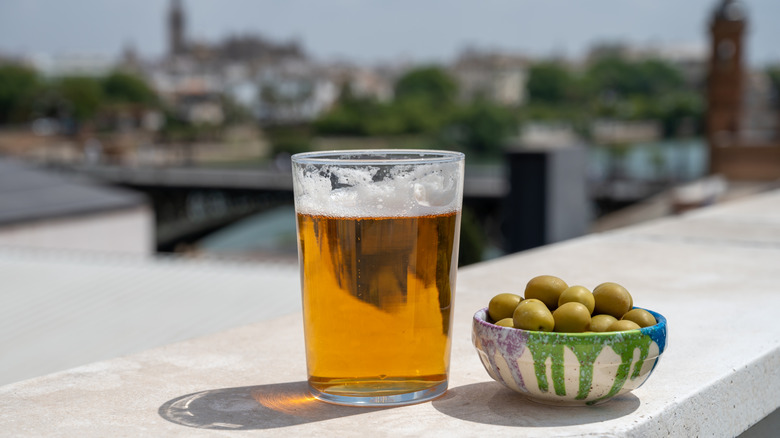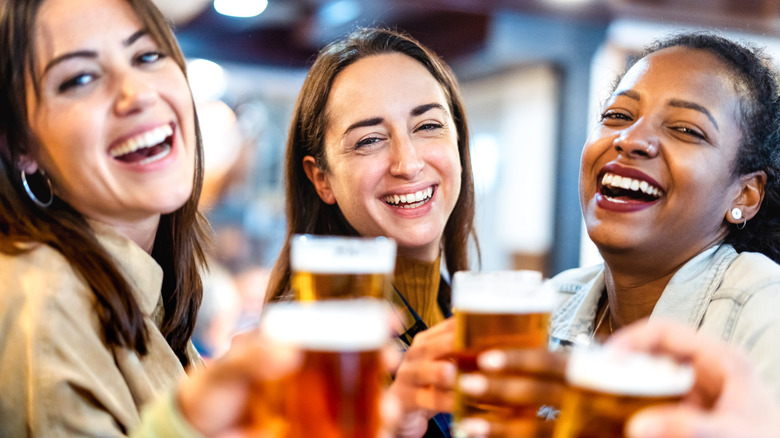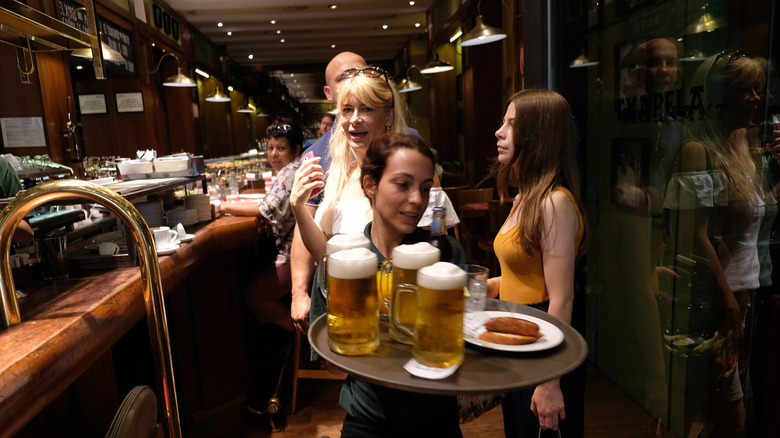How To Ask For Your Beer In Spain (And Impress The Bartender)
Imagine that it's the height of summer and you're taking a road trip around Spain, stopping off along the way to explore. It's been a scorching afternoon with the thermometer hitting the mid-90s, and you've spent the day spelunking the ancient city of Granada's enchanting, medieval streets, soaking up hundreds of years of culture, architecture, and history. You're hot, sun-zapped, and ready for a break in a cool place, so you duck into a little bar to quench your thirst with an ice-cold beer.
You pull up a stool, greet the bartender in your best Spanish, and continue with: "Una cerveza, por favor." He sees that you're a tourist and responds with a bit of English: "What kind?" It's a small bar with only one beer on tap, so you just point to it and say, "That one, por favor." The bartender then laughs and shakes his head. "Sí, sí, yo entiendo," he says, "... but what kind?"
Unlike other parts of the world, where ordering a beer is straightforward, things can get a bit complicated in Spain, where cold suds are served up in a variety of sizes and glasses, each with its own specific name. Just like when ordering food at restaurants in this Mediterranean country, it pays to know what to ask for. So before you head off on any Spanish adventures, familiarize yourself with these basic terms, lest you find yourself red-faced with embarrassment in a hole-in-the-wall boozer in Valencia.
Size isn't everything
The first thing you need to figure out is if you're after a bottle or a glass of draft beer. Many bars in Spain serve both, so know that "una botella" means "a bottle," which usually contains 11 fluid onces of beer. Just signify which brand and be done with it. Though if you really want to put a smile on the bartender's face, go native and call it "un tercio." There are even smaller bottles called "quintos" that are only 6.7 fluid ounces, but these are usually served as part of a "cubo" (bucket).
Draft beer is sometimes poured in a pint glass in Spain — called "una pinta" — especially in places with lots of British tourists. However, the most common order — especially during the sweltering months of the summer — is "una caña." This diminutive glass contains the same amount of beer as "un quinto" and may look overly-petite to some, but bigger is not always better: "Una caña" is small enough that it won't get warm before you're through with it. There's even a smaller pour called "un corto," that comes in at just 4 fluid ounces. However, if you're in the mood for something a bit bigger, request "un doble," which, as it sounds, it just about twice the size of "una caña." There is also "un tubo," which is a tall, thin glass that — like un tercio — is usually 11 fluid ounces.
How to go big if the mood strikes you
Of course there may be days in Spain when your thirst is too mighty for a small pour to satisfy. In that case you can ask for "una jarra," which is mug or jar of beer. This is the most bang for your buck, though sometimes "una jarra" may mean a massive pitcher of served with separate glasses to share with a group, so make sure to check first. If you're in the mood to go old school, see if your fine drinking establishment will serve a "porrón." This traditional glass flask is usually filled with wine and passed around between friends, though beer can be substituted as well.
For something light and refreshing, try ordering "una clara" (a shandy made from beer and sparling lemonade or soda), and if you'd like to cool down with a beer but wish to avoid the alcohol, just ask for "una cerveza sin" (which means "without"). Despite the fact Spain is largely known as a wine country (it's the third-biggest producer in the world), Spaniards actually drink more beer than vino, and their beer industry is one of the largest in Europe.
Famous brands include Mahou – the grandaddy of Spanish beer — as well as Estrella Damm. San Miguel, Estrella Galicia 1906, Alhambra Especial, and Cruzcampo — which sponsors the national soccer team — are also popular. Whichever you opt for, just remember that the vessel is nearly as important as the brand. However, if you do make a mistake and end up with, say, una caña when you wanted una jarra, just lean back, drain the cold glass, and then ask for one more. On the subject of drinking etiquette, here's how to avoid a common coffee faux paux in Italy.


